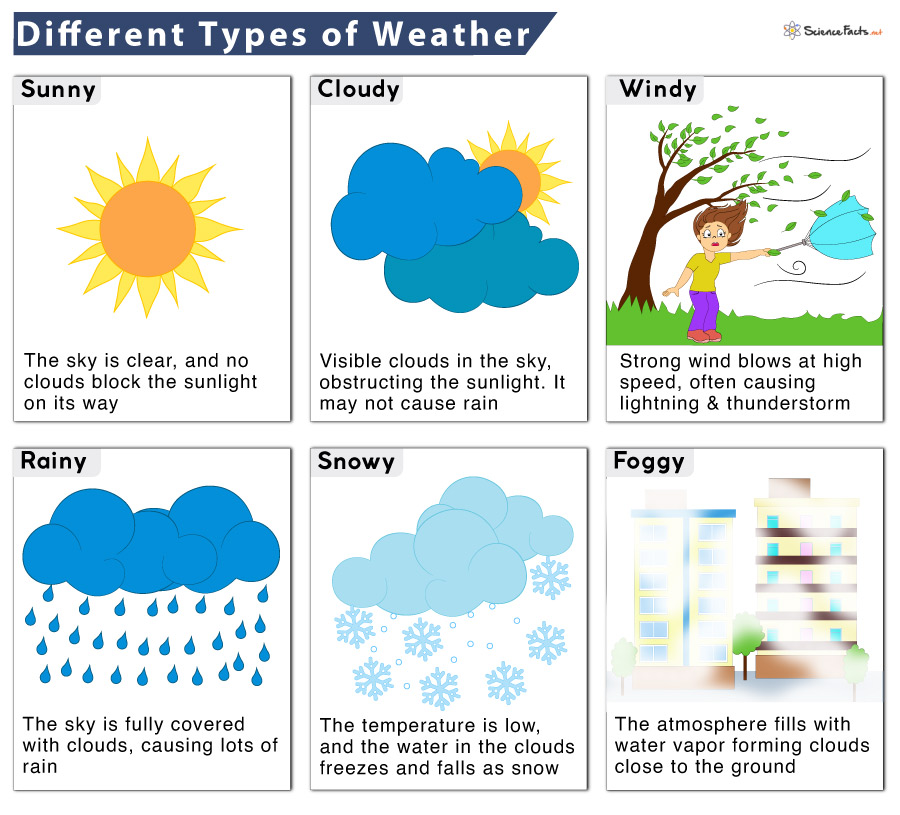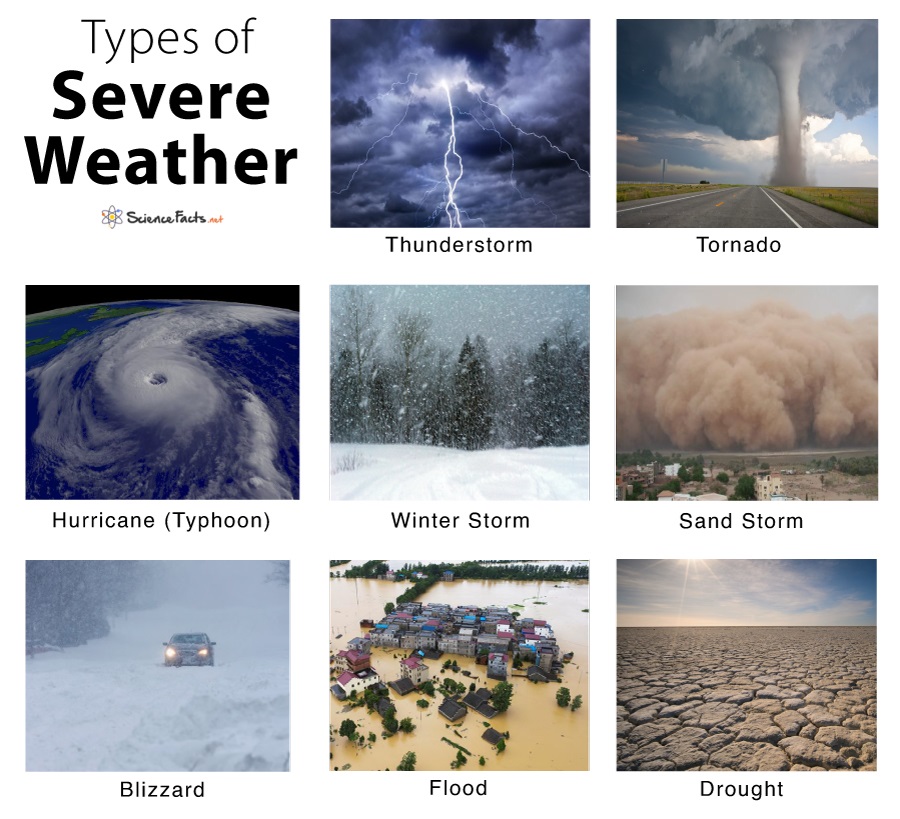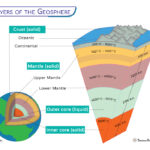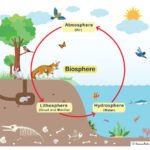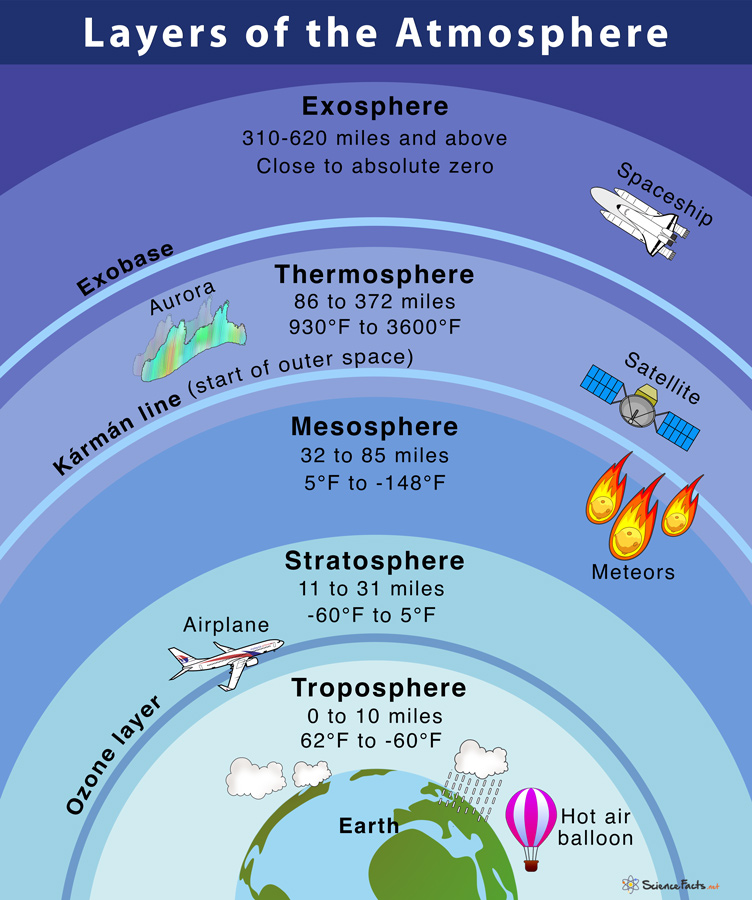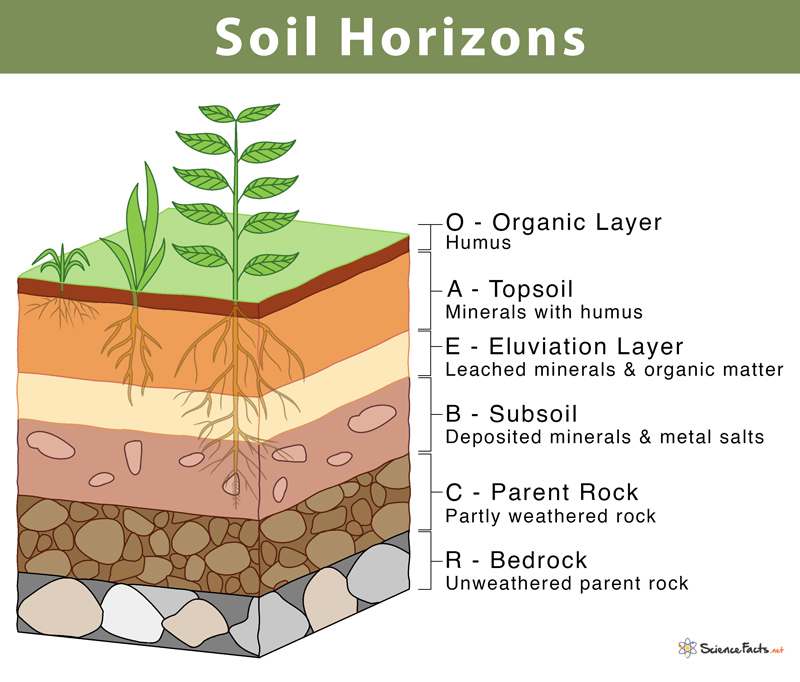6 Different Types of Weather
Weather is the state of the atmosphere during a given time at a given place. It is affected by several different atmospheric factors and the location.
Factors Affecting Weather
There are different types of elements affecting the weather. They are:
1. Temperature
It indicates how fast air molecules and atoms are moving in the atmosphere. If the atoms are moving fast, the temperature is high, but if they are moving slow, the temperature is low. Temperature thus determines the hotness and coldness of a place, thus affecting the weather.
2. Humidity
It refers to the amount of water vapor or moisture in the air. Tropical regions have high humidity, whereas arid regions have low humidity. It is always better to balance the amount of water vapor in the air. Humidity also determines if there is a chance of dew, fog, or precipitation and thus is often the cause of change in the weather.
3. Precipitation
There are different ways in which water returns to the Earth’s surface from the atmosphere. Rain, snow, sleet, ice, hail, and drizzle are the different forms of precipitation. The temperature in the air determines the type of precipitation. For example, if the temperature is sufficiently low, water droplets will freeze and fall as hail or snow.
4. Wind
The movement of air near the Earth’s surface depends on the uneven heating of the Earth. Since wind carries moisture, it is the cause of rain, and the type of wind blowing can change the weather and climate in a place.
5. Clouds
They are the primary carrier of moisture and thus the cause of precipitation. The amount of clouds often determines the amount of precipitation in a place and thus is one of the leading causes of change in the weather.
6. Atmospheric Pressure
It is the weight of the air pushing on the Earth’s surface. Low-pressure systems bring clouds and precipitation, whereas high-pressure areas are usually associated with cool temperatures, dry weather, and clear skies.
Different Types of Weather Conditions
There are six main types of weather found on the Earth’s surface. They are:
1. Sunny
It is a condition where the sky is clear, and no clouds are blocking the sunlight. The temperature during such weather is warm. Sunny weather is typical in the spring and summer seasons but is also found in autumn and winter.
Sunny weather encourages outdoor activities such as playing games and sports and going on a vacation. Such condition also helps plants to produce their food.
We should use suns cream to protect our skin from sunburn and drink plenty of water to keep our body hydrated.
2. Cloudy
Such conditions happen when clouds obstruct the sunlight on its way to the Earth’s surface. Cloudy days can be cold or warm, depending on the humidity, which may or may not accompany the rain. It is most common in autumn and winter but also in spring and summer. Usually, cloudy days are hot in summer and cold in winter.
We often use terms like ‘partly cloudy’ and ‘overcast’ to describe the number of clouds that covers the sky. When the condition is partly cloudy, only a few visible clouds are in the sky, partly covering the sun. However, if clouds entirely cover the sky and the sky looks gray and dark, it is an overcast condition. Such weather indicates heavy rain accompanied by lightning and thunderstorm. The World Meteorological Organization describes this weather when clouds cover at least 95% of the sky.
Cloudy weather prevents us from outer outdoor activities. We are not encouraged to go outdoors during cloudy weather as thunderstorms and lightning often accompany it.
3. Windy
Wind can be defined as air in motion. It happens when there is a pressure imbalance between two regions. Air moves from a high-pressure region to a low-pressure region. We experience the motion of air as wind.
Windy weather is often accompanied by lightning and thunderstorm, destroying lives and properties such as agricultural fields, roads, and transport.
Windy condition is commonly seen in the mountains, where the weather becomes hot during the day compared to the plains. This temperature change causes the warm air to rise, and the cool air from the plains rushes to take its place, causing the wind to blow. This phenomenon reverses at night, causing the wind to blow in the opposite direction.
We must stay indoors as much as possible during windy weather for our safety.
4. Rainy
This type of weather happens when the sky is covered with clouds. Thus, cloudy weather (either partial or overcast) can become rainy weather when the clouds are large, causing much precipitation.
There are certain hilly regions where one can see a rainy day continuously throughout a week or even months. At the same time, in some other parts, such as deserts, one can hardly encounter rain throughout the year.
Rain is beneficial for plants since they get water to produce their food. One must wear a raincoat or carry an umbrella outdoors during a rainy season.
5. Snowy
They are usually seen in winters when the precipitation in the clouds freezes and becomes snowflakes due to low temperature. The precipitation finally falls as snow instead of rain.
Snowy weather is cold but allows many fun activities such as ice-skating, sledding, throwing snowballs, and making a snowman.
We must wear woolen clothes such as jackets, socks, and gloves to protect ourselves from the cold.
6. Foggy
Although not very common, they can happen anywhere, anytime. Fog develops when water vapor condenses and stays in the air, forming clouds close to the ground.
They are found to occur commonly in the late autumn, winter, and early spring. Fog reduces visibility; thus, vehicle drivers are advised not to drive in such conditions. Also, fog increases the humidity level and thus causes more problems for humans.
Types of Severe Weather
Apart from the six main types of weather conditions, sometimes the weather can become more dangerous and cause natural disasters costing the lives of millions. They are:
- Thunderstorms are often the result of overcast conditions. Thunderstorms include rain, hail, storm, thunder, and lightning. They can be partly or very severe.
- Tornadoes develop from thunderstorms when warm air collides with cold air, creating a narrow, rotating column of air. Similar to thunderstorms, tornadoes also vary in severity.
- Hurricanes and Typhoons are high-speed spiraling storms that are long-lasting. Such storms develop over water and can produce winds of 200 mph. Storms from the north of the Pacific Ocean are called typhoons, while storms from the north of the Atlantic Ocean are called hurricanes.
- Winter Storm occurs in cold temperatures, causing rain to freeze and create snow and ice. Winter storms form after much snowfall.
- Sand Storms happen when the strong wind moves dust and sand, taking them to another place.
- Blizzards are a type of harsh snowstorm that occurs for long periods. Blizzards also accompany strong winds, heavy snowfall, and sub-zero temperatures.
- Flood occurs due to heavy rain over a long time period.
- Droughts are long periods without rain or precipitation and can happen worldwide. Droughts can last for months to years and can cause forest fires and famines.
FAQs
Ans. South Carolina’s weather is humid and subtropical, with long, hot summers and short, mild winters.
Ans. Most collisions usually occur during rainfall or just after rainfall.
-
References
Article was last reviewed on Friday, February 17, 2023

